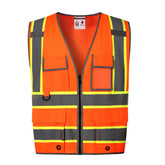What Is a Surveyor’s Safety Vest?
Safety and Visibility in the Field
Surveyors often work in challenging outdoor environments—along highways, on active construction sites, and in areas with moving vehicles or heavy machinery. In these conditions, visibility is critical for safety. A surveyor’s safety vest is designed to make workers highly visible while providing the functionality needed to carry out precise, technical tasks in the field.
What Is a Surveyor’s Safety Vest?
A surveyor’s safety vest is a type of high-visibility (hi-vis) vest specifically tailored for land surveyors and field engineers. Unlike standard reflective vests, these are built with extra storage, enhanced durability, and compliance with ANSI/ISEA 107 safety standards.
Typically, surveyor vests come in Class 2 or Class 3 configurations, depending on the level of visibility required. Their bright fluorescent colors—usually orange or yellow-green—combined with wide reflective tape bands, make surveyors stand out in daylight and low-light conditions.
Key Features and Functions
1. High-Visibility Materials
The most recognizable part of a surveyor vest is its bright, reflective surface. Made from fluorescent fabrics with reflective tape placed on the chest, shoulders, and back, these vests ensure visibility from every angle. This design is essential for surveyors working near traffic or heavy equipment.
2. Multiple Pockets & Tool Organization
A major difference between a surveyor’s vest and a regular safety vest is the number of pockets. Surveyors carry pens, field books, measuring tapes, markers, radios, and GPS units—all of which require organized storage. A quality vest often includes front utility pockets, a large back map pocket, and reinforced compartments for heavy or sharp tools.
3. Comfort and Fit
Surveyors spend long hours outdoors. A well-designed vest uses breathable mesh or lightweight polyester to reduce heat buildup while maintaining strength. Adjustable sides or zippered fronts improve comfort and allow easy layering over other clothing.
4. Durability
Because surveyors often move through brush, mud, or construction debris, durability matters. Heavy-duty zippers, reinforced seams, and rugged fabric ensure the vest withstands rough use without tearing.
5. Additional Functional Features
Some models include radio tabs, microphone clips, ID holders, and D-rings for attaching instruments. These small details make a big difference in workflow efficiency and safety.
ANSI Safety Standards Explained
In the U.S., the ANSI/ISEA 107 standard sets the performance criteria for high-visibility safety apparel. It defines three visibility classes based on the amount of reflective material and background fabric.
-
Class 1: For low-risk environments (e.g., parking attendants)
-
Class 2: For higher-risk areas with traffic up to 50 mph—ideal for most surveyors
-
Class 3: For the highest visibility needs, such as roadside or nighttime surveying
Choosing an ANSI-compliant vest ensures surveyors meet workplace safety regulations and remain visible in all lighting and weather conditions.
Surveyor’s Vest vs. Regular Safety Vest
While both garments improve visibility, their functions differ:
-
Regular Safety Vest: Basic reflective vest, usually with minimal storage and lighter fabric—suitable for general workers or event staff.
-
Surveyor’s Safety Vest: Engineered for professionals who need to carry equipment, documentation, and small tools while staying highly visible.
In short, every surveyor’s vest is a safety vest—but not every safety vest is suitable for a surveyor.
How to Choose the Right Surveyor’s Vest
When selecting a surveyor vest, consider:
-
Work environment: Day vs. night, roadside vs. construction zone
-
Visibility level: Choose Class 2 or Class 3 compliance
-
Storage needs: Number and size of pockets
-
Comfort: Mesh for hot climates, solid fabric for durability
-
Fit and adjustability: For layering over jackets or rain gear
Professional-grade vests, like those available at HiVisPro.com, combine visibility, comfort, and utility for maximum performance in the field.
Conclusion
A surveyor’s safety vest is an essential part of modern fieldwork safety. Beyond visibility, it helps professionals stay organized, efficient, and compliant with U.S. safety standards. Whether you’re mapping new terrain or managing construction layouts, investing in a quality hi-vis surveyor vest means investing in your own protection and productivity.





